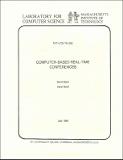Computer-based Real-time Conferences
Author(s)
Sarin, Sunil K.; Greif, Irene
DownloadMIT-LCS-TM-282.pdf (8.165Mb)
Metadata
Show full item recordAbstract
A real-time conferencing system allows a group of users to conduct a problem-solving meeting from their workstations. Participants in such a conference use the computer to jointly view, edit, and process relevant information, and use voice communication to discuss the information they are sharing. General principles are presented in this paper for selecting a set of user functions in a real-time conferencing system. The available implementation strategies are reviewed and compared, with emphasis on the tradeoffs between reusing existing single-user interactive programs and writing new distributed multi-user programs. Network communication requirements for real-time conferences, and their potential impact on communication protocol standards, are discussed. Real-time conferencing is contrasted with aynchronous communication support such as electronic message systems and shared databases, and the need for the two to work together within the total system environment is emphasized.
Date issued
1985-07Series/Report no.
MIT-LCS-TM-282